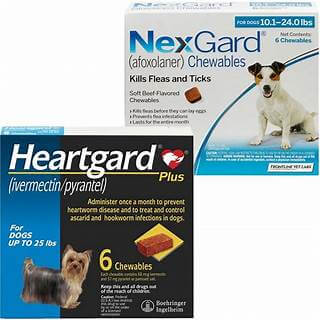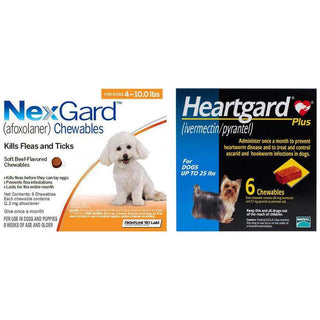
As a responsible pet owner, you might be asking, "When should I start flea and tick prevention for my puppy?" or "What flea and tick treatment is safe for young dogs?"
The right time to begin flea and tick protection depends on the product you choose and your puppy's specific needs.
Always carefully follow the product instructions, which are usually provided on the packaging.
Let's explore when to start your puppy's flea and tick prevention, why it's essential, and how to choose the best option for your pet.
When To Begin Flea And Tick Treatment For Puppies
Most flea and tick prevention products for puppies can be used once they are 6 to 8 weeks old.
However, certain products, like Bravecto (oral and topical), can't be used until your puppy reaches six months of age.
Consulting with your veterinarian is key to choosing the right tick and flea treatment to protect your puppy's health.
Why Flea and Tick Control Is Crucial for Puppies?
Fleas and ticks are harmful external parasites that can cause health issues in both pets and people. The CDC and state health departments report these parasites are present across all 50 states. Puppies are particularly vulnerable to fleas and ticks during outdoor activities like walks and playtime. Additionally, puppies may contract internal parasites such as roundworms, which can be passed from their mother before they are adopted. Some of these parasites are zoonotic, meaning they can also infect humans.
Many flea and tick treatments for puppies also protect against internal parasites, offering an added safety layer for the puppy and its human family.
If your puppy already has fleas or ticks when you bring them home, your vet may prescribe treatment to remove the parasites before starting preventative measures.
When choosing flea and tick prevention, consider the following factors with your vet:
- The most convenient dosing method (oral tablets, topical treatments, or collars)
- The number and type of pets in the home
- Any young children or immunocompromised family members
- The home’s outdoor environment
- Your puppy’s future activities (dog shows, sports, etc.)
- Your puppy’s age, weight, and health
While flea and tick prevention comes with a cost, it is far more affordable than treating diseases caused by these parasites. Gaps in prevention can lead to drug-resistant fleas and ticks, increasing health risks.
Ticks can transmit several severe diseases, including:
- Lyme disease
- Babesiosis
- Ehrlichiosis
- Rocky Mountain spotted fever
- Anaplasmosis
- Tularemia
- Colorado tick fever
Certain ticks are more common in specific regions of the U.S., including:
- Lone Star tick
- American dog tick
- Rocky Mountain wood tick
Fleas can also spread tapeworms, plague, and cat scratch disease to pets and humans. If your puppy has fleas, you may notice flea dirt, which looks like tiny dark specks near the base of the tail. Fleas feed on blood, causing pain, itching, allergic reactions, and sometimes more severe health issues.
How to Choose the Best Flea Treatment for Puppies
Flea and tick prevention is essential to keeping your puppy healthy and safe. It's important to start your puppy on a flea and tick treatment suitable for its age and weight, as it helps protect it from parasites and the diseases it can carry.
Some treatments not only prevent fleas and ticks but also protect against intestinal parasites, offering extra protection for your puppy and even reducing the risk of these parasites spreading to you.
There are many safe and effective products available that prevent or treat flea and tick infestations. To make the best choice for your puppy, it helps to understand some common differences between fleas and ticks, as well as how the treatments work:
- Fleas and ticks have different life cycles: fleas go through egg, larval, and adult stages, while ticks progress through nymph, larval, and adult stages.
- Female and male ticks of the same species may look different.
- Some treatments target specific stages of the flea or tick life cycle, while others are effective against multiple stages.
- The type of tick prevalent in your region may also influence the best medication for your puppy.
Since fleas and ticks are present in the environment and often carried by wildlife, it's important to treat all pets in your household—both dogs and cats—and take steps to control pests in your surroundings. Environmental treatments include:
- Using products designed to kill or control fleas and ticks
- Trimming bushes and shrubs
- Cleaning up leaves and yard debris
- Reducing standing or stagnant water
- Limiting wildlife exposure
- Keeping wood piles away from your home
If you're unsure which flea and tick treatment is best for your puppy, your veterinarian can guide you in making the right choice.
Types Of Flea And Tick Control For Puppies
Some flea and tick treatments combine different ingredients to protect against multiple parasites. However, it's important to consider your puppy's breed and specific needs when choosing a product, as some breeds can be sensitive to certain drugs.
For example, some Collies, Sheepdogs, and their crossbreeds have a genetic mutation known as MDR1, which makes them sensitive to certain medications, such as:
- Ivermectin
- Moxidectin
- Selamectin
- Milbemycin oxime (found in products like Heartgard and Nexgard Plus)
- Simparica Trio
- Trifexis
- Advantage Multi
- Revolution
While dogs with the MDR1 gene can have adverse reactions to these drugs, the low doses used in heartworm prevention are generally safe, provided your vet approves.
The MDR1 gene mutation affects a protein responsible for eliminating drugs from the body and protecting the brain and other organs. In dogs with this mutation, the inability to remove these substances can lead to a buildup of drugs in the brain, resulting in severe neurological problems.
Please always consult your vet before giving your puppy any tick and flea treatment to ensure its safety, especially if it belongs to a sensitive breed.
Which Flea And Tick Treatment Is Safe For Puppies?
It’s essential to avoid using flea and tick products designed for cats on dogs, as dogs and cats metabolize medications differently. The dosage and strength of medication vary between species based on their weight.
Always use flea and tick treatments that are specifically labeled for dogs and ensure they are suitable for your puppy's weight to prevent toxicity. Here are some common prescription treatments for puppies:
- Type: Topical, monthly
- For puppies 6 weeks and older
- Treats: Heartworms (adults), fleas (adults and eggs), American dog ticks, ear mites, and sarcoptic mange
- Type: Oral, monthly
- For puppies 8 weeks and older
- Treats: Adult fleas, Lone Star, American dog, black-legged, and brown dog ticks
- Type: Oral, monthly
- For puppies 8 weeks and older
- Treats: Heartworms, intestinal parasites (roundworms and hookworms), adult fleas, Lone Star, Gulf Coast, American dog, black-legged, and brown dog ticks
- Type: Topical, monthly
- For puppies: 7 weeks and older
- Treats: Heartworms (adults and microfilaria), adult fleas, intestinal parasites (roundworms, hookworms, whipworms), and sarcoptic mange
- Type: Oral, monthly
- For puppies 6 weeks and older
- Treats: Heartworms (adults), flea eggs, and intestinal parasites (roundworms, hookworms, whipworms, tapeworms)
Please consult your veterinarian to ensure you choose the best and safest flea and tick treatment for your puppy depending on their specific needs.
Please note: The information in this post is for educational purposes and should not be taken as medical advice. For a proper diagnosis and treatment plan for your pet, consult your veterinarian.






